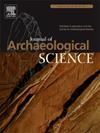过去2000年米兰女性和男性的压力标记和存活率
IF 2.5
1区 地球科学
Q1 ANTHROPOLOGY
引用次数: 0
摘要
本研究结合古病理学数据和古流行病学分析,特别是生存分析,研究了8种生理和机械应力标记对5个历史时期492名成年米兰男性和女性样本的生存的影响。对整个数据集进行Pearson卡方检验、事后检验和生存分析。研究结果显示,某些应激标志物,如眶嵴、股骨和/或肱骨嵴、多孔性骨质增生和线状牙釉质发育不全,与生存率降低有关,而骨关节病和施莫尔淋巴结与生存率增加有关。Harris纹和死前外伤对寿命无显著影响。对各个历史时期的分析表明,生活条件在近代有所恶化,但在近代有所改善。尽管罗马时期女性的存活率较低,但骨骼压力标记在女性中的低流行率表明,其他因素或危险,如分娩,在更大程度上影响了女性的虚弱。在现代,颅骨后冻伤、骨质疏松和哈里斯系与女性生存率降低有关,这反映了更多的环境压力,而在罗马、中世纪早期和现代,冻伤和骨质疏松与男性生存率降低有关。这些发现为压力标记对米兰生存和死亡率的历史影响提供了强有力的见解,并提高了我们对过去2000年来米兰男性和女性生活质量的理解。本文章由计算机程序翻译,如有差异,请以英文原文为准。
Stress markers and survivorship over the last 2,000 years in Milanese females and males
This study combines paleopathological data and paleoepidemiological analyses, specifically survival analyses, to investigate the impact of eight physiological and mechanical stress markers on survivorship in a sample of 492 adult Milanese males and females across five historical periods. Pearson's Chi-squared, post-hoc tests, and survival analyses were performed on the entire dataset. The findings reveal that certain stress markers, such as cribra orbitalia, cribra femoralis and/or humeralis, porotic hyperostosis, and linear enamel hypoplasia, were associated with decreased survivorship, while osteoarthrosis and Schmorl's nodes were associated with increased survivorship. Harris lines and antemortem trauma did not significantly affect longevity. Analysis across historical periods indicated that living conditions deteriorated through the Modern era but improved in recent times. Despite lower survival among females in the Roman period, the low prevalence of skeletal stress markers in females suggests that other factors or hazards, such as childbirth, influenced female frailty to a greater degree. In the Modern era, post-cranial cribriotic lesions, porotic hyperostosis, and Harris lines were associated with decreased survival in females, reflecting greater exposure to environmental stressors, whereas cribriotic lesions and porotic hyperostosis were associated with decreased survival among males in the Roman, Early Medieval, and Modern eras. These findings offer robust insights into the historical impact of stress markers on survivorship and mortality in Milan and improve our understanding of the quality of life of males and females in Milan over the last 2000 years.
求助全文
通过发布文献求助,成功后即可免费获取论文全文。
去求助
来源期刊

Journal of Archaeological Science
地学-地球科学综合
CiteScore
6.10
自引率
7.10%
发文量
112
审稿时长
49 days
期刊介绍:
The Journal of Archaeological Science is aimed at archaeologists and scientists with particular interests in advancing the development and application of scientific techniques and methodologies to all areas of archaeology. This established monthly journal publishes focus articles, original research papers and major review articles, of wide archaeological significance. The journal provides an international forum for archaeologists and scientists from widely different scientific backgrounds who share a common interest in developing and applying scientific methods to inform major debates through improving the quality and reliability of scientific information derived from archaeological research.
 求助内容:
求助内容: 应助结果提醒方式:
应助结果提醒方式:


